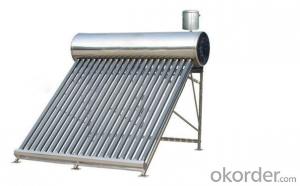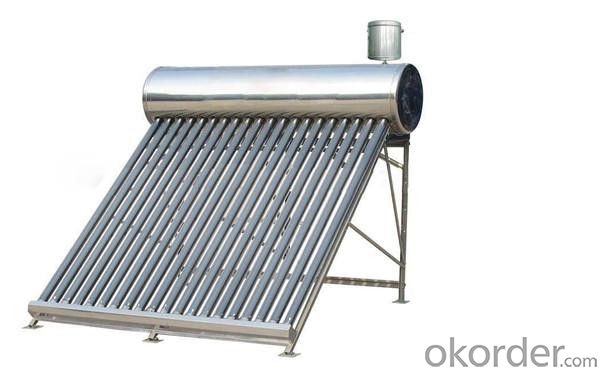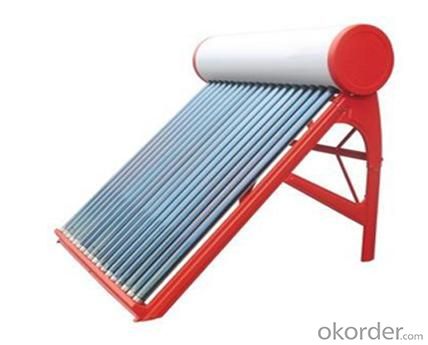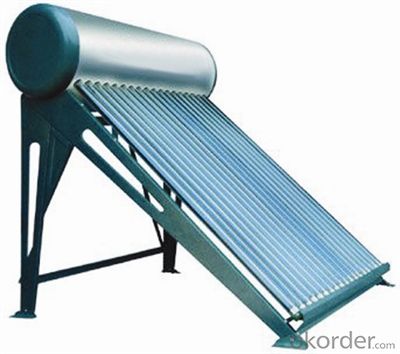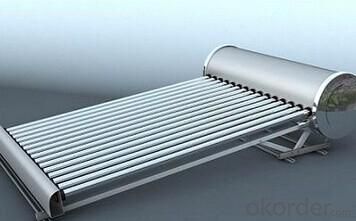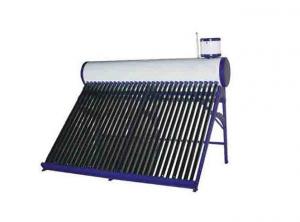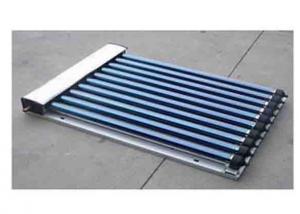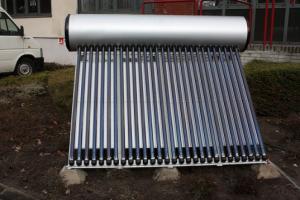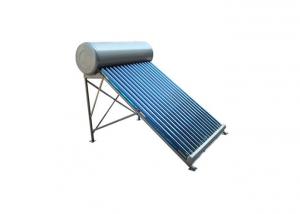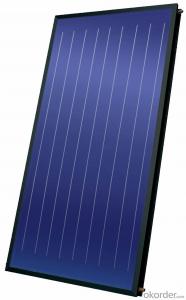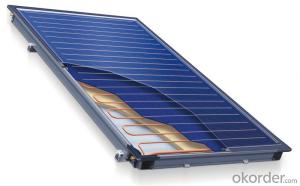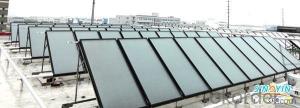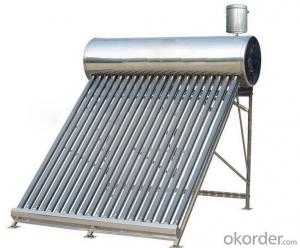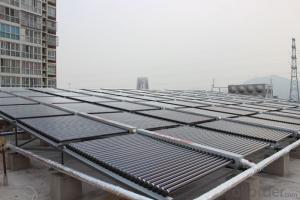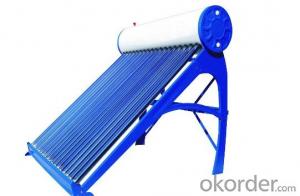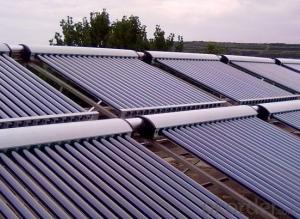Indoor Solar Collectors Non-Pressurized Heat Pipe Copper Solar Water Heater System
- Loading Port:
- China main port
- Payment Terms:
- TT OR LC
- Min Order Qty:
- 1 set
- Supply Capability:
- 6000 set/month
OKorder Service Pledge
OKorder Financial Service
You Might Also Like
Introduction of Non-Pressure Solar Water Heater:
Non-pressure Solar Heater is one of the most economical solar water heating device with pretty high efficiency at the same time. It consists of hot water storage tank, solar vacuum tubes with mouth plug in storage tank, and bracket supporting tank and tubes.When cold water in evacuated tubes is heated with solar irradiation, as the specific gravities of hot water and cold water are different, hotter water goes upward to storage tank and colder water goes downward to glass tubes. through this continuous circulation, the cold water in storage tank will be gradually heated till sunset.
Specialty:
1. High thermal performance and working temperature: the heat exchanging rate even in winter can up above 55%.
2. Heat collecting efficiency is at least 20% above common solar systems.
3. Work in all day and all season: no matter any corner of the world, this system can work well even -40℃ to avoid the tube freezing problem.
4. Reliability: No water following through the tube, so water scale can not generate and tube cracks could be avoided, the system still can keep working even with some damaged tubes.
5. It can connect with water tap and work automatically with pressure0.6Mpa, bring enjoyable washing experience.
6. Safety: P/T valve would release pressure and temperature to protect tank..
Technical Specification:
1. Outer tank material: SUS304 stainless steel or powder coated color steel
2. Inner tank material: 1.2mm thick SUS304 food grade stainless steel ( Optional material SUS316L)
3. Vacuum tube material: borosilicate glass 3.3; AL-SS-CU absorb coating, with copper heat pipe inside
4. Frame material: 1.2mm thickness stainless steel
5. Insulation material: 55mm thickness polyurethane
6. Suitable for mains pressure water(up to 8 bar/116psi)
7. Easy plug-in installation
8. Install the T/P valve on the pressurized tank
9. Seal material: Stabilized High Temperature Silicon
Outer tank material: SUS304 stainless steel or powder coated color steel
Inner tank material: 1.2mm thick SUS304 food grade stainless steel ( Optional material SUS316L)
Vacuum tube material: borosilicate glass 3.3; AL-SS-CU absorb coating, with copper heat pipe inside
Frame material: 1.2mm thickness stainless steel
Insulation material: 55mm thickness polyurethane
Suitable for mains pressure water(up to 8 bar/116psi)
Easy plug-in installation
Install the T/P valve on the pressurized tank
Seal material: Stabilized High Temperature Silicon
19. Vacuum Tube | 20. Size (mm) | 21. Φ47*1500 / Φ58*1800 / Φ70*2100 | |||||
22. Tube (pcs) | 23. 10 / 12 / 15 / 18 / 20 / 22 / 24 / 30 / 36 / 42 | ||||||
24. Material | 25. Borosilicate 3.3 glass, magnetron spluttering selective coating | ||||||
26. Coating | 27. Single-target AL-N/AL or Three-target AL/N-Cu-SS | ||||||
28. Water Tank | 29. Capacity | 30. 80L ~ 500L for hot water storage tank | |||||
31. Inner tank | 32. Food-grade stainless steel SUS304-2B / SUS316 | ||||||
33. Insulation | 34. High-density polyurethane foam with 70~80 hour heat preservation | ||||||
35. Tank shell | 36. Food-grade stainless steel SUS304-2B | ||||||
37. Bracket | 38. Shaped strong aluminum alloy structure adaptable for flat or slope roof | ||||||
39. Accessories | 40. Anti-aging silicon seals, Dustproof seals, Air-vent cap, Stainless screws | ||||||
41. Auxiliary Devices | 42. Assistant tank, Intelligent controller, Electrical heater, Magnesium anodes | ||||||
43. Tilt Angle | 44. 25 ~ 50° | ||||||
45. Water Output | 46. 45 - 95°C | ||||||
47. Hail Resistance | 48. Φ25mm diameter | ||||||
49. Model Number | 50. Solar Vacuum Tube | 51. Tank 52. Liter | 53. System 54. Liter | 55. Container Loading Qty /sets | |||
56. Size /mm | 57. Qty /pcs | 58. 20GP | 59. 40GP | 60. 40HQ | |||
61. VNS-58SA12-100 | 62. Φ58*1800 | 63. 12 | 64. 100 | 65. 132 | 66. 58 | 67. 119 | 68. 140 |
69. VNS-58SA15-130 | 70. 15 | 71. 130 | 72. 170 | 73. 54 | 74. 108 | 75. 131 | |
76. VNS-58SA18-150 | 77. 18 | 78. 150 | 79. 198 | 80. 43 | 81. 86 | 82. 105 | |
83. VNS-58SA20-170 | 84. 20 | 85. 170 | 86. 223 | 87. 40 | 88. 80 | 89. 97 | |
VNS-58SA24-200 | 24 | 200 | 263 | 35 | 70 | 85 | |
VNS-58SA30-250 | 30 | 250 | 329 | 28 | 56 | 68 | |
VNS-58SA36-300 | 36 | 300 | 395 | 23 | 47 | 57 | |
Product Show
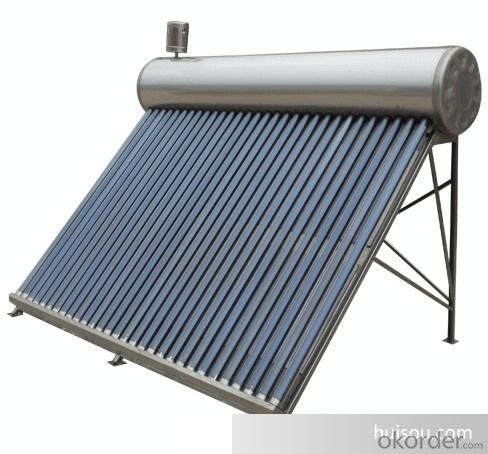
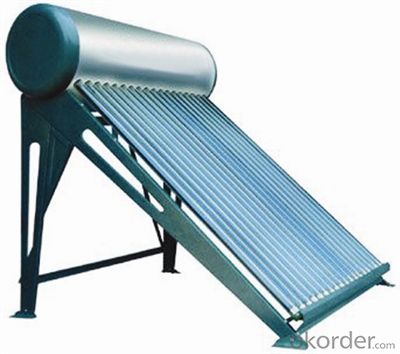
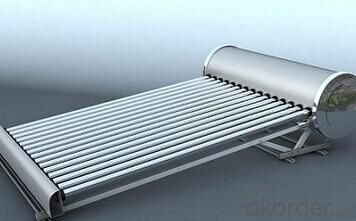
Our Services
1. OEM service
2. Warranty: 5 years
3. Considerable after sale service
Color steel Compact pressure Thermal solar heater
FAQ:
1. What’s the delivery time?
10 days after receiving deposit.
2. How long is the warranty?
5 years for whole system, 1 year for accessory
3. What’s your production capacity?
6000sets/month
4. What’s the MOQ?
1 set.
5. What’s your payment term?
Container: 30% T/T in advance for deposit, 70% T/T before shipment for fist order.
70% T/T after seeing copy of B/L from second order
Sample: 100% T/T in advance
Other choices: L/C at sight.
6. What certifications do you have?
CE, SOLAR KEYMARK, SRCC and etc.
- Q: How do solar collectors affect the environment?
- Harnessing the sun's energy, solar collectors contribute positively to the environment by generating electricity or heat without emitting harmful pollutants or greenhouse gases. This utilization of renewable energy helps decrease our reliance on fossil fuels, which are major contributors to air pollution and climate change. Moreover, solar collectors have a limited impact on land usage. They can be easily installed on rooftops, avoiding the need for additional land or disruption of natural ecosystems. Furthermore, these collectors can be integrated into existing infrastructures, such as parking lots or agricultural fields, optimizing their efficiency and minimizing adverse effects on the environment. Conservation of water is also a significant aspect. Conventional power generation methods like coal or natural gas consume substantial amounts of water for cooling purposes. Conversely, solar collectors operate without the need for water, therefore preserving this valuable resource. It is true that the production of solar collectors does have some environmental implications, particularly regarding the mining and manufacturing processes required for the necessary materials. However, these impacts are relatively minimal when compared to the long-term benefits of solar energy utilization. Overall, solar collectors make a positive impact on the environment by reducing greenhouse gas emissions, conserving water, and minimizing land usage. They play a critical role in the transition towards a more sustainable and clean energy future.
- Q: Are there any limitations to the angle of installation for solar collectors?
- Yes, there are limitations to the angle of installation for solar collectors. The optimal angle for solar collectors depends on the latitude of the installation location and the time of year. In general, solar collectors should be installed at an angle that maximizes the amount of sunlight they receive throughout the year. In locations closer to the equator, where the sun is higher in the sky year-round, solar collectors are typically installed at a steeper angle, usually around 30 to 40 degrees. This allows for maximum solar radiation absorption throughout the day. In areas farther from the equator, where the sun's angle changes significantly throughout the year, solar collectors are often installed at a shallower angle. This helps to optimize solar energy absorption during the winter months when the sun is lower in the sky. However, there are limitations to the angle of installation. If the angle is too steep or too shallow, it can result in reduced energy production. Steeper angles may cause snow or debris to accumulate on the solar panels, hindering their efficiency. Shallower angles may result in less solar radiation absorption, especially during the winter months. Other factors that may limit the angle of installation include space constraints, structural limitations, and aesthetic considerations. In some cases, the angle of installation may need to be adjusted to accommodate these factors, even if it is not optimal for maximum energy production. Overall, while there are limitations to the angle of installation for solar collectors, careful consideration of the location, time of year, and other factors can help ensure maximum energy production and efficiency.
- Q: Can solar collectors be used for heating grain storage facilities?
- Yes, solar collectors can be used for heating grain storage facilities. Solar thermal systems can capture solar energy and convert it into heat, which can then be used for various purposes, including heating grain storage facilities. This can help maintain optimal temperature and humidity levels for grain storage, preventing spoilage and maintaining grain quality.
- Q: How do solar collectors impact property values?
- Solar collectors can have a positive impact on property values as they are considered a valuable and environmentally-friendly addition. The increased energy efficiency and potential savings associated with solar collectors make properties more attractive to potential buyers, leading to a potential increase in property value.
- Q: Can solar collectors be used for heating office buildings?
- Yes, solar collectors can be used for heating office buildings. Solar thermal systems can capture the sun's energy and convert it into heat, which can then be used for space heating in office buildings. This can help reduce the reliance on traditional heating systems, lower energy costs, and contribute to a more sustainable and environmentally friendly approach to heating.
- Q: What is the lifespan of the absorber coating in a solar collector?
- The lifespan of the absorber coating in a solar collector can vary depending on various factors such as the quality of the coating, maintenance practices, and environmental conditions. However, on average, a well-maintained absorber coating can last between 15 to 20 years.
- Q: Can solar collectors be used for desalination?
- Yes, solar collectors can be used for desalination. Solar collectors can generate heat which can be used to evaporate saline water, leaving behind the salt and other impurities. This process is known as solar desalination and it is an environmentally friendly way to produce fresh water from saltwater sources using solar energy.
- Q: Can solar collectors be used for industrial process heating?
- Yes, solar collectors can be used for industrial process heating. Solar thermal collectors can capture and convert sunlight into heat energy, which can then be utilized for various industrial processes such as heating water, generating steam, or providing direct heating for manufacturing processes. This renewable and sustainable energy solution can help reduce reliance on fossil fuels and lower greenhouse gas emissions in industrial sectors.
- Q: Can solar collectors be used for heating emergency response facilities?
- Yes, solar collectors can be used for heating emergency response facilities. Solar thermal systems can effectively capture and convert sunlight into heat energy, which can then be used to provide heating for buildings. By using solar collectors, emergency response facilities can reduce their reliance on traditional heating systems and decrease their carbon footprint while ensuring a reliable source of heating during emergencies.
- Q: Can solar collectors be used for heating vehicles?
- Solar collectors have the capability to heat vehicles. They are able to capture the sun's energy and convert it into heat. This heat can then be utilized for various purposes, including heating vehicles. By implementing solar collectors on the roof or other suitable areas of the vehicle, the energy collected from the sun can be used to warm the interior or even preheat the engine coolant. This helps to reduce the reliance on traditional heating systems and decrease the vehicle's impact on the environment by minimizing the use of fossil fuels. It should be noted, however, that the effectiveness of solar collectors for vehicle heating may vary depending on factors such as the size of the collectors, the amount of sunlight available, and the specific heating needs of the vehicle.
Send your message to us
Indoor Solar Collectors Non-Pressurized Heat Pipe Copper Solar Water Heater System
- Loading Port:
- China main port
- Payment Terms:
- TT OR LC
- Min Order Qty:
- 1 set
- Supply Capability:
- 6000 set/month
OKorder Service Pledge
OKorder Financial Service
Similar products
Hot products
Hot Searches
Related keywords
